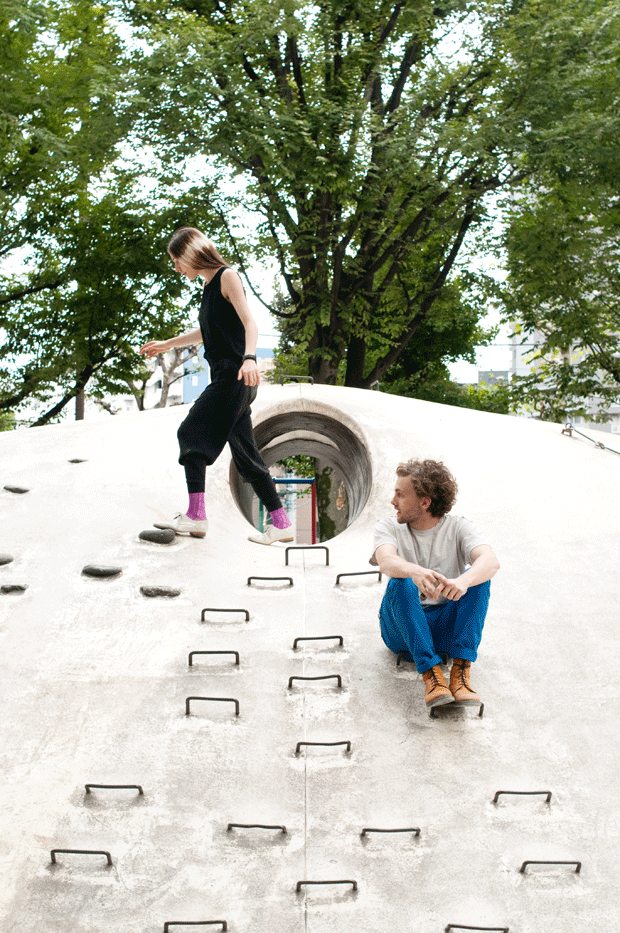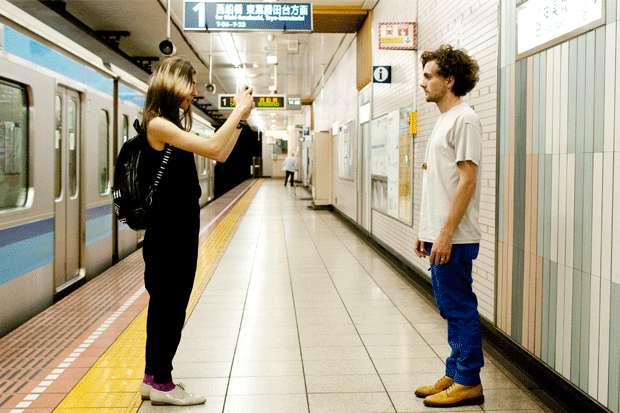A swell of US-based artists, musicians, photographers and designers converged recently in the Tokyo streets for what seemed like a spontaneous expatriate rager that pushed on night after night. Performing as a duo, Caroline Polachek and Patrick Wimberly of Chairlift arrived on time to mark the release of the Japanese language version of "I Belong in Your Arms" in the form of a limited 7-inch. FADER caught up with the band in the Shimbashi Geisha district for some conveyor belt sushi, Kimono shopping and a DJ set in a white, mirrored room, which seemed a perfectly unfamiliar backdrop for reflecting upon some of the deeper aspects of their sound.
Caroline, you lived in Japan until you were six. Do you feel you still have some strange subconscious connection to this country? POLACHEK: Hite! Yeah, it’s really cool to be back, cause all the things you notice when you are an adult—like the way the streets are laid out, the sense of humor, or the way people dress—you don’t notice that when you are a kid. You just pay attention to candy wrappers, flowers, animals and illustrations. But the textures of things here—fabrics, ceramics, and gold embroidery—all those things trigger all sorts of feelings. It feels really natural to be here in a way.
Patrick, have you been to Tokyo before? WIMBERLY: No, but we had to come. We were just touring in Australia and you think, Hey we’re so close to Japan, we should go, but then your realize it’s really not that close. It's like being in New York and saying, Hey we gotta go to Sau Paulo. But I am really excited to be here, regardless.
Your Japanese tour coincides with your release of “I Belong In Your Arms,” sung in Japanese. How does it feel to actually perform that song in Tokyo?POLACHEK: It feels weirdly natural. Singing that song in America in Japanese, at least on stage, feels a bit awkward—like people might think it’s a gimmick or something. But actually, I wanted to do it in Japanese purely as an aesthetic thing. The character of the song always reminded me more of a Japanese world than an American or even an Anglo one, so it seemed more faithful to the song to sing it in Japanese. To sing it here just feels like the song “came true” or something.
You guys performed as a duo instead of as a full band. Have you ever done that before? POLACHEK: We almost never play as a two-piece, actually. Chairlift, technically speaking, is just the two of us writing and recording, and then we flesh it out with additional members on stage. We’ve been touring as a four or five-piece for the last year, depending on whether or not I play synths. This album was really written to be played by a full band, so it feels weird to play it as a two-piece, but in this case, it turned into some kind of surrealist karaoke. I made projections in the hotel room the day we got here, and there was a TV screen on the opposite side of the venue from the stage, so there was this unexpected element of me being able to see how I “sat” in the projections while performing, and I could move around to step in and out of certain shapes while singing. That was awesome. I want to set it up on purpose like that some time. Nobody questioned the two-piece set either. Makes me want to do it more.

The outro to the song "Cool As Fire" has a real smooth operator vibe. Did working with Dan Carey influence that? POLACHEK: I think as I get older, I’m just going to start making smooth, new age music—no joke. Dan Carey [who mixed the album], thankfully, has the opposite impulse: he loves things that are fast and hard and visceral. He really acted as an amplifier for us while making this album. He does everything that a great amp does: makes things louder, more textured, more distorted. If left to his own devices, he’d just make krautrock all day. He was amazing to work with. I did all my vocal takes right in front of him and Patrick, in the same room. They’d listen with headphones with their eyes closed.
Where do the sounds that you use come from? POLACHEK: We take a lot of care in our sound choices. In a lot of cases, the synth sounds are almost vocal, like characters. “Amanaemonesia,” in particular, has a lot of little characters that come in and out, like in Looney Tunes or Fantasia. It’s probably clear on the album that I spent the last year or so gorging on ’80s synth music. The bands I was probably the most influenced by, purely sonically, were Strawberry Switchblade, Bill Nelson Yellow Magic Orchestra, OMD, Art Of Noise. But I was also listening to Japanese classical music, and getting introduced to black metal by my boyfriend at the time, Jorge Elbrecht of Violens. I didn’t like a lot of it cause I have a hard time with Cookie Monster vocals, but the stuff I really liked influenced me a lot. The drum beat for “Met Before,” for example, is right out of a black metal song I was listening to on repeat. But for the lyrics and songwriting, we tried to keep it as pure and personal as possible, as close [as possible] to our own idea of pure pop-song. References only went as far as sonics. WIMBERLY: There are a lot layers in there, and it’s hard to show people that we aren’t really attached to any genre. I guess there is something about musicians also being the producers—knowing how to play the music as well as use all the gear to [produce it]
Why do you often put lyrics in your videos? WIMBERLY: There is so much music where people hide behind production. POLACHEK: It’s cool, though, My Bloody Valentine did that. I think anything can be done well. But I wanted the karaoke-style lyrics in our music videos for two reasons: first, cause nobody has lyric booklets anymore, and when I was growing up, lyric booklets were like little bibles. I want people to be able to access our lyrics without having to go to some gnarly website with banner ads. Secondly, the songs on this album are really traditional pop songs; we didn’t make house music, or experiment with the format at all. So I wanted to show that it was a conscious choice to make songs made for singing. If the lyrics are scrolling on the screen, even if you’re not actually singing along, your brain is singing along and you get more pleasure out of seeing the lyrics get hit one by one. [It's] like watching someone playing tennis; there’s a kind of participation there, in the anticipation. It's kind of the difference between using the voice as a medium for song, and using the vocals as an instrument. Like Cocteau Twins’ Liz Frasier—[she] really uses her voice as an instrument. Lyrics really aren’t the point. Sometimes you can combine the two. I really like when the lyrics in the music have an interesting relationship between one another—where they contrast each other. Like this song by Mylene Farmer, called "Maman a tort"— this song is very much like Chairlift, almost a mix between "Planet Health" and "Take It Out on Me." The song is from the point of a little girl who keeps telling her mom she is sick so she can go to the hospital because she has a lesbian crush on the nurse. The song has this little kid melody, but the lyrics are really heavy. One, mamma was wrong; two, love is beautiful; three, the nurse is crying; four, I love her.
And the video opens with a photo of Freud and there is a table with the girls head on it... POLACHEK: Ha, I guess it’s a bit of a try hard song, but an amazing one.




